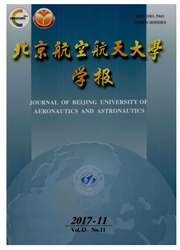

 中文摘要:
中文摘要:
对机翼防冰过程中冰脊的形成特点及冰脊对机翼气动特性的影响进行了计算分析.基于经典的Messinger结冰模型开发了多步结冰程序,对不同条件下过冷水滴的撞击结冰进行了热质耦合计算,计算结果和文献试验结果吻合较好,表明该热质耦合算法的正确性.在此基础上对不同环境温度、飞行速度和不同加热功率等条件下冰脊的生长特点和机翼的气动特性进行了计算分析.结果表明:在非霜冰条件下,冰脊主要在热防护极限外并紧挨着热防护极限的位置处形成和发展,而在霜冰条件下,冰脊主要在机翼下表面形成,但是在热防护区域内有显著的结冰出现,该条件下的结冰对机翼的气动特性具有较大的破坏性.
 英文摘要:
英文摘要:
The calculation was performed on runback ice and its effects on the aerodynamic characteristics of the airfoil.A multi-step ice accretion code was developed based on the classical Messinger icing model and it was used to predict the ice shapes in different conditions.Good agreement between the calculation results and the experimental data indicates the heat-mass coupled arithmetic is correct.Base on the arithmetic,the growth of the runback ice and the aerodynamic characteristics of the airfoil were calculated.The results indicate that the runback ice is likely to form outside the thermal protection area and begins to grow near the position of the thermal protection limit in non-rime ice conditions.However,in rime ice conditions,the runback ice is more likely to form at the lower surface of the airfoil and there is significant ice accretion in the thermal protection area and because of this the aerodynamic characteristics of the airfoil is destroyed greatly.
 同期刊论文项目
同期刊论文项目
 同项目期刊论文
同项目期刊论文
 期刊信息
期刊信息
